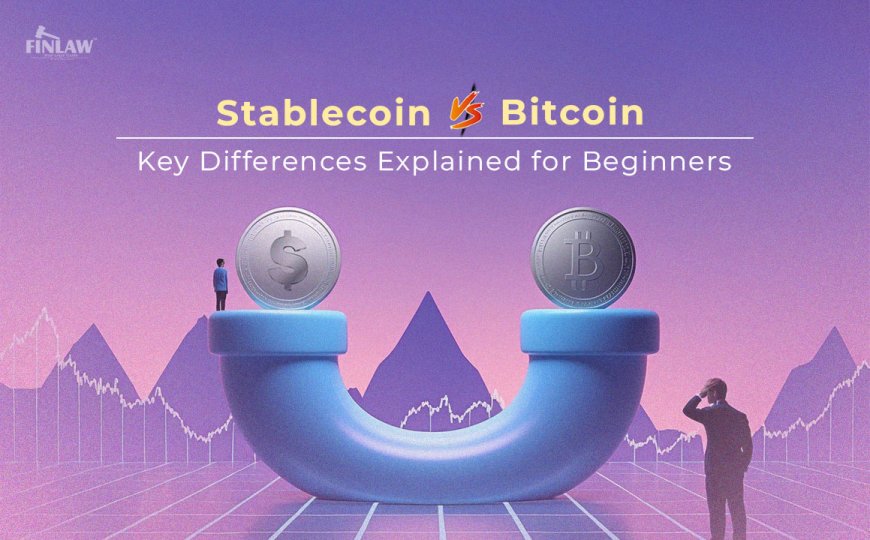Stablecoin vs Bitcoin: Key Differences Explained for Beginners
Learn the key differences between stablecoins and Bitcoin, their uses, risks, and which is better for you as a crypto beginner.

The cryptocurrency universe is sprawling, rapid, and sometimes even slightly confusing at first. There are thousands of coins and tokens flipping around hundreds of platforms, and because of all the jargon, it can be easy to feel lost. But ultimately, there are 2 types of digital assets everyone should be concerned about, bitcoin and stablecoins.
If you are a newcomer to crypto, you've likely heard these two terms. You may have even thought about which was safer, or which was better to invest in. This is where the stablecoin vs bitcoin conversation becomes an interesting topic. Although both bitcoin and stablecoins fall within the idea of blockchain, they both have completely different functions and risk profiles.
In this post, we will explain what Bitcoin and stablecoins are, how they differ, and which one of them will be better and suitable option for you depending on your situation.
What is Bitcoin?
Bitcoin is the first cryptocurrency ever created. It was created in 2009 by an unknown creator going by the name Satoshi Nakamoto, and it brought the idea of decentralized digital money to the world. Unlike traditional currencies that are centralized and controlled by a bank (or central bank), Bitcoin is run on a decentralized network that is referred to as a blockchain, which is essentially a public, immutable ledger of all transactions that occur.
One of Bitcoin's most notable aspects is its scarcity. There will only ever be 21 million bitcoins, which is what makes it a deflationary asset by nature. As demand rises, but supply does not, the price will often rise—sometimes considerably.
This leads to one of Bitcoin's most popular aspects: volatility. Bitcoin has rewarded early investors with massive returns, but it has also lost value quickly. Price could lose several thousands of dollars to gain just as much in days or hours. Because of this, many people consider Bitcoin, a store of value, referring to it as "digital gold". It is seen by some as a hedge against inflation, currency devaluation, and centralization of the financial system.
Even with all the fluctuations and volatility in price, Bitcoin can still be used for transactions. Transferring money over borders, purchasing goods or services, and tipping content creators are examples—the differences between those uses and just holding and hoping for price appreciation is the experience of using Bitcoin. However, due to its value fluctuating, Bitcoin is used more as a long-term investment than as a currency for daily transactions.
What Is a Stablecoin?
Bitcoin has volatile pricing swings, while stablecoins were developed to counteract this volatility. A stablecoin is a cryptocurrency whose price is tied to a less volatile asset; usually a fiat currency but could also be a commodity like gold. In essence, stablecoins aim to provide the usability of blockchain technology (e.g., fast and borderless transactions) and the reliability of fiat money.
There are three types of stablecoins.
-
Fiat backed stablecoins are the most prevalent stablecoins. Fiat backed stablecoins are pegged 1:1 to fiat currency and backed by real reserves stored in bank accounts, e.g., USDT (Tether) and USDC (USD Coin).
-
Crypto-collateralized stablecoins, also known as crypto backed stablecoins are pegged with cryptocurrencies, such as Ethereum, using smart contracts to stabilize the price. They are typically over-collateralized to take into account fluctuations in value that occur in the market. An example of this would be DAI, which is backed and collateralized through MakerDAO protocol.
-
Algorithmic stablecoins are not backed or collateralized, but instead follow a computer algorithm that adjusts its supply. While these are stablecoins, they have proven to be an experimental and riskier class of stablecoin, as evident in the 2022 doomsday event around TerraUSD (UST).
Stablecoins have many uses. They allow for the trading in cryptocurrencies to take place without having to cash-out into a fiat currency. They can also be used for international payments, savings or temporary safe havens when the crypto market has become too volatile.
Stablecoin vs Bitcoin: The Fundamental Differences
Both Bitcoin and stablecoins are built upon blockchain technology, but their purposes are fundamentally different.
Bitcoin was designed to solve a fundamental problem: to offer an alternative financial system that is decentralized, limited in supply, and completely independent from any government. Value is comprised of supply and demand in a competitive marketplace, so it serves as a great speculative asset or long-term investment—but it also comes with extreme volatility, which can be seen as a positive or a concern.
Stablecoins offer the opposite of volatility—they are formed for stability. Value is pegged to something familiar and reliable, like the U.S. dollar. Instead, stablecoins are designed as usable tools for day-to-day transactions, hedging, or fast trading, with less volatility, and more convenience, no major price fluctuations.
In terms of supply, Bitcoin has a limited supply, capped at 21 million. Most stablecoins have an adjustable supply according to market demand and their level of reserves.
Bitcoin is completely decentralized—there is no central authority controlling it. Most stablecoins (especially fiat-backed like USDC) are issued from centralized companies, which operate in governance and need to comply with regulations, possibly blocking an account, thus stablecoins tend to have a higher level of centralized control.
Which is Better? The Battle Between Stablecoin and Bitcoin
That depends on what you wish to accomplish.
If your goal is long-term investments, grow wealth or hedge against inflation, then Bitcoin is likely a better option. Its limited amount and decentralized nature are attractive to anyone who believes in the future of crypto as an alternative to fiat.
On the other hand, if you're searching for something reliable to store value in the short-term with fast transactions or trade other cryptocurrencies without price volatility from the underlying asset, stablecoins may be a better choice.
Many savvy crypto users will hold both. They maintain their Bitcoin as a long-term investment, while using stablecoins for liquidity, trading, or transferring money daily.
Risks to be Aware Of
We must acknowledge that both Bitcoin and stablecoins have their own risks.
In Bitcoin's case, the most glaring risk is price volatility. Price fluctuations can happen suddenly and significantly reduce value. Bitcoin may be subject to regulatory reviews in some countries and is always subject to the whims of policymakers, regulators, and public sentiment. If you lose access to your wallet or private keys, the bitcoins you have are gone—it is extremely difficult to recover. You might never recover it as well.
Stablecoins have an appeal in their being stable and hence less risky on the pricing front. But stablecoins have their own risks and challenges. Not all stablecoins are fully backed and not all issuers are transparent. There is also the risk of de-pegging and the stablecoin loses its connection with the underlying asset, as we saw with failures in the past like UST. And centralized stablecoin issuers can be subject to regulatory enforcement and we see examples of issuers stopping services, freezing assets, or shut down altogether.
That being said, the leading stablecoins, like USDC and USDT, have become widely utilized and, at least in the past, relatively reliable—especially when they were fully backed and audited.
Final Thoughts: Summary of Distinctive Points
Above all, understanding the stablecoin vs bitcoin distinction is critical, especially for anyone new to the digital asset landscape.
Bitcoin is an exciting, decentralized innovation that holds long-term value potential—but it can be volatile. Many view it as a store of value, akin to adding a bit of digital gold to your mix when investing.
Stablecoins are all about predictability and less of volatility. They are designed to give users both the benefits of traditional finance and the blockchain experience of a crypto currency, so people can enjoy both the benefits of fast-moving, reliable capital as well as the value of using their local currency.
Neither stablecoins or bitcoins are better or worse than one or another—it just really depends on what you want to accomplish. The correct answer for most individuals is to use both for their respective benefits: bitcoin to store and accumulate value; stablecoins to transact and spend in a stable environment.
With the dynamic and ambiguous crypto landscape, developing an understanding of the strengths and weaknesses of both will help give you the confidence to navigate your own financial future. Investing, transacting, or experimenting with what the future of money may be, you will have some understanding to evaluate the trade-offs between stablecoins and bitcoin.
What's Your Reaction?



















